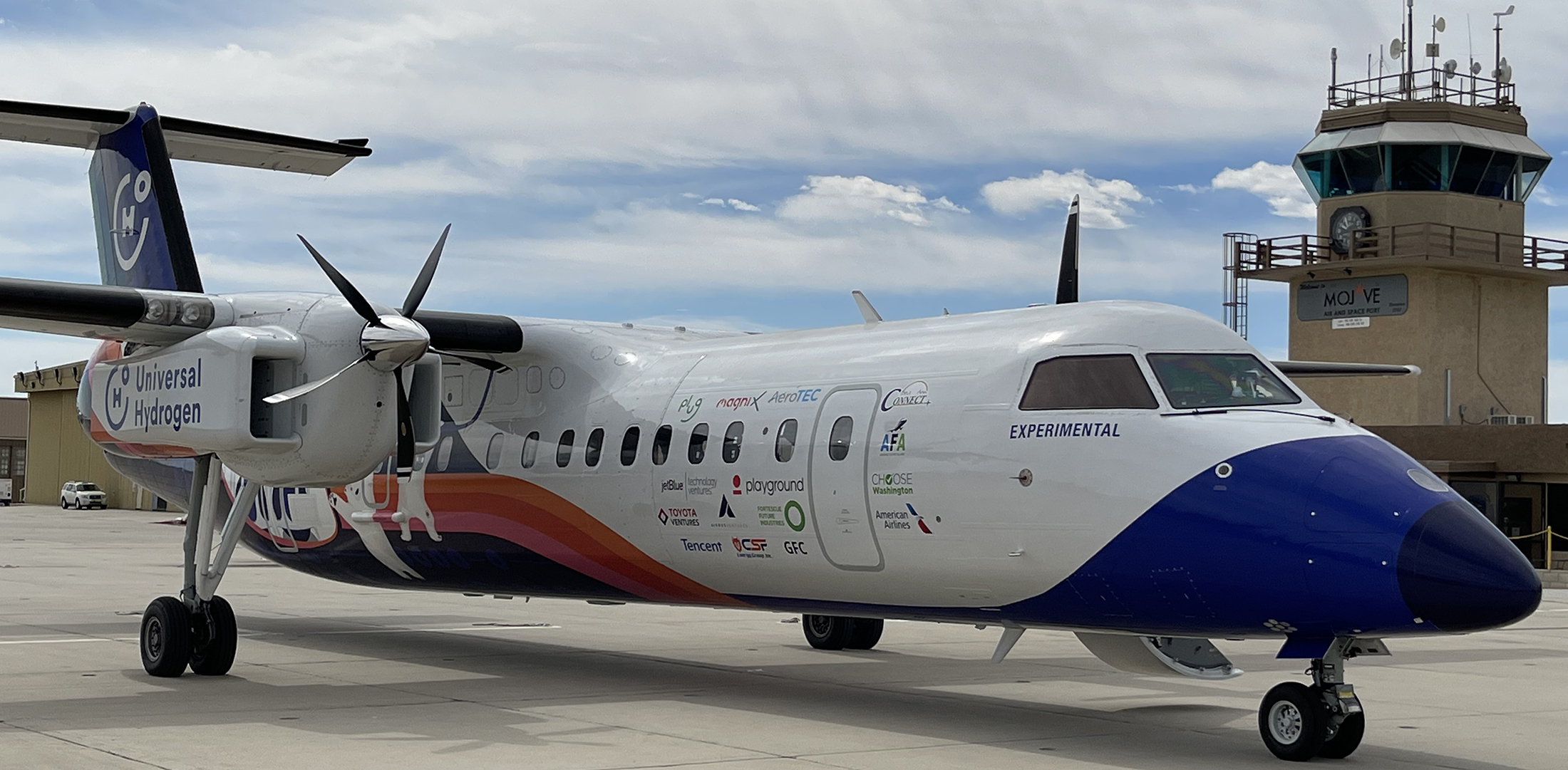After successfully flying a De Havilland Dash 8 turboprop retrofitted with a hydrogen fuel cell propulsion system in Washington state, Universal Hydrogen has relocated its flight testing activities to the Mojave desert in Southern California, the company announced Thursday.
The Hawthorne, California-based tech start-up says it has successfully completed four additional flight tests since its hydrogen-powered Dash 8 first took to the skies on March 2. While the flight test campaign started at Grant County International Airport in Moses Lake, Washington, all subsequent flight testing will take place at the Mojave Air & Space Port. The company’s Dash 8 testbed, nicknamed “Lightning McClean,” recently made the journey from Moses Lake to the new flight test center, making four stops along the way across Oregon and California, according to Universal Hydrogen.
“In our relentless pursuit to decarbonize aviation, moving our flight testing to Mojave brings us closer to our headquarters in Hawthorne, ensuring optimal coordination with the team,” said Mark Cousin, Universal Hydrogen’s chief technology officer. “We extend our gratitude to Washington state and specifically Moses Lake for their invaluable support as we began our historic test flights with the largest hydrogen fuel cell-powered aircraft. Our calculated testing strategy guarantees the safety of our converted aircraft, propelling us towards our goal to have it in service within the next two years.”
Universal Hydrogen has been developing hydrogen powertrain conversion kits for legacy aircraft since 2020 and aims to have its first products certified and in service by 2025, starting with a conversion kit for the 72-passenger ATR 72-600 regional airliner and then the Dash 8. The megawatt-class powertrain for the 40-passenger Dash 8 is essentially the same as what Universal Hydrogen is developing for the ATR 72-600.
The company plans to start delivering conversion kits for auxiliary power in larger, single-aisle aircraft in the late-2020s and then as a primary fuel by the mid-2030s. It is also developing a modular hydrogen delivery system to reduce the need for costly new hydrogen infrastructure at airports that will support hydrogen-powered aviation.
For its initial flight testing campaign, Universal Hydrogen replaced one of the two turboprop engines in the Dash 8 testbed with a hydrogen fuel cell powertrain housed entirely within one of the nacelles. The first flight of the retrofitted Dash 8 on March 2 lasted about 15 minutes, during which the aircraft reached an altitude of 3,500 feet. It doubled that duration with its second flight and ascended to 5,000 feet. The Dash 8 completed its third and fourth flight tests on June 12, reaching 10,000 feet. Once the technology is certified, it will be able to operate at 25,000 feet, a company spokesperson told FutureFlight.
Universal Hydrogen's powertrain uses hydrogen fuel cells provided by Plug Power, which operates out of Spokane, Washington. MagniX, based in Everett, Washington, provided its magni650 electric propulsion unit and associated power electronics. The powertrain does not involve batteries; rather, electricity from the hydrogen fuel cells powers the electric motors directly.
In 2021, Universal Hydrogen announced it was working with Plug Power, MagniX, and Seattle-based AeroTec to set up a new Hydrogen Aviation Test and Service Center at Grant County International Airport. That center was intended to support the development and certification of Universal Hydrogen's Dash 8 as well as future powertrain conversion work for its U.S.-based airline customers. The Universal Hydrogen spokesperson told FutureFlight that the company no longer plans to use this facility for any future certification or aircraft conversion efforts. “The reasoning for the move was to be closer to their global headquarters in Hawthorne, California, as well as to take advantage of a strong engineering talent pool in Mojave and Los Angeles,” they said.
When Lightning McClean made its way south to Mojave, the hydrogen fuel cell powertrain was fully utilized during takeoff for all four legs of the 800-nm journey. In the first three legs, the pilots throttled down the hydrogen system after takeoff and flew using just the one turbine engine. For the fourth and final leg, they left the hydrogen powertrain turned on for the duration of the 180-nm flight, which took just over an hour. According to Universal Hydrogen, this is the longest flight by a hydrogen fuel cell powertrain to date.
While Universal Hydrogen is not the first company to successfully fly an airplane on hydrogen fuel cells, it has certainly flown the largest one to date. ZeroAvia, a British-American company developing a similar conversion kit for the 19-seat Dornier 228, achieved its first flight about six weeks before Universal Hydrogen first flew its 40-passenger Dash 8.
